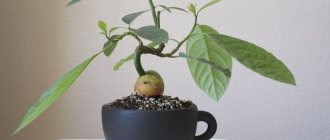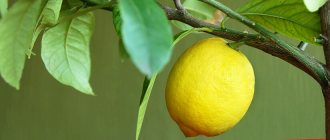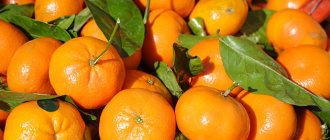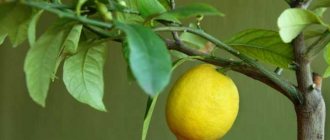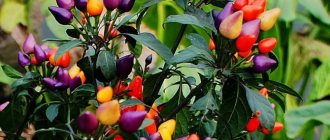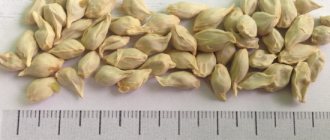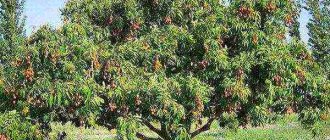How to choose a mango for planting
Choose ripe, juicy fruit, which should be very fragrant and slightly soft. Don't go by color because different varieties vary significantly. It’s better to pay attention to the presence of dark spots - this is a sure sign that you need to take it!
Overripe mangoes are also suitable for planting, although you will not be able to eat the pulp. To the touch, such fruit is strongly pressed, it has an unpleasant smell and taste. If no ripe fruits are found in the vicinity, you can buy green ones and put them in paper to ripen for a couple of days in a dark place.
Photo: m.aksam.com.tr
How mangoes grow from seeds
In tropical conditions, the tree reaches a height of 40 meters or more. A young mango tree begins to bear fruit at ten years of age. The lifespan of individual trees reaches hundreds of years. An adult tree has a wide crown, with a diameter of up to 15 meters. Blooms in February-March. The scent of the flowers is reminiscent of lilies. The bud and its petals are yellowish-red in color. Numerous inflorescences form a flower.
Leaves emerge from many rosettes located on the branches. The color of the leaves of mature trees is dark green, while that of young plants is yellowish and pinkish. The length of the leaves is up to 30 cm. The roots of this tree are powerful, highly developed, and in natural conditions go to a depth of 10 meters.
The fruit is soft, reaches a weight of two or more kilograms, juicy, very rich in vitamins and microelements. The skin of the fruit contains the toxic substance urushiol, which can cause a reaction in the skin and internal soft tissues of the body in those prone to allergies. It is better for such people to peel mangoes with gloves.
There are about 200 varieties of mangoes distributed on the planet. The main two varieties of mangoes spread from India and Indochina, the rest - by crossing. Indian mango is a round fruit, red or yellow. Indochinese mango is a greenish oblong fruit.
Previously, Asian rulers' own mango gardens were considered a sign of high social status. Mango wood is highly durable and has a beautiful structure. In Eastern countries it is used to make jewelry, beads, boxes, and vases. Oil for cosmetic purposes is made from the kernels of the seeds.
How to get a bone
The mango seed is securely hidden in the shell, which must first be cleared of pulp. Rinse it well under cool water and examine it for damage. If there is a crack on the shell, split it completely, and if not, carefully cut it with a knife.
Carefully remove the seed from the shell and place it in a solution of potassium permanganate for disinfection for 7-10 minutes. You can use ready-made store-bought fungicides, but follow the instructions on the package strictly. You need to plant the seed right away, otherwise it will dry out in a couple of days and will definitely not sprout.
How to grow mango from seed yourself
Nurseries and botanical gardens sell grafted mango seedlings. This method of cultivation does not require significant effort when planting at home, and there is a high probability that the tree will have a high yield. Mostly low-growing varieties are purchased.
When growing from a seed, it is not possible to identify a dwarf tree. The main thing is to choose a seed from a well-ripened fruit. The skin of this fruit has a red or yellow tint, the flesh is juicy, and the seed comes off effortlessly. It's even better to use overripe fruit. The kernels in them sometimes begin to germinate on their own.
The planting process begins with germination. A tree will not grow from a dried seed. The extracted seed from the fruit is carefully cleaned from the pulp with a clean knife, washed well, and placed in a glass container with warm water. The water is changed daily. Once the sprout appears, the mango can be planted in a pot.
You can germinate in another way by wrapping the kernel in a damp cloth. The fabric should be constantly moistened and kept in a warm place. In some mango varieties, the pit is sealed so tightly that water cannot flow inside. The sprout will not sprout and the mango will not grow.
Another way to plant mangoes. Using a sharp knife, carefully open the shell. It is important not to damage the process on the nucleus. Prepare a plastic glass with a lid in advance. For this method of planting, it is better to buy a ready-made, already disinfected, soil mixture. The glass is filled with soil and the seed is planted in the hole with the sprout facing up.
Cover the seed completely with soil, water thoroughly and cover with a lid to maintain the microclimate. Remove the cover periodically for ventilation. After two leaves hatch, remove the lid. Transplant the shoot into a pot after it gets stronger.
Pots for planting mango pits
A pot with a diameter of up to 14 cm is suitable for planting. Small drainage holes are cut in the bottom of the pot. A small layer of expanded clay, pieces of ceramic products, crushed stone, pebbles, broken bricks, and fine gravel are placed on the bottom. They promote ventilation of the roots of the seedling and protect against rotting.
Planting soil can be prepared yourself or bought at flower shops. The soil is packaged and labeled, soil components and acidity levels are indicated. The seed will also germinate well in soil for succulents or cacti.
You can prepare the soil yourself. Coconut substrate, peat and perlite are mixed in equal proportions. You can also use a mixture of turf and humus soil mixed with sand for germination. In self-prepared soil, you need to determine the acidity level. In soil with low or high acidity, the plant will begin to hurt and disappear. Soil acidity is checked with a pH meter. A litmus paper indicator can be used. Litmus changes color when it comes into contact with soil. When growing mangoes from seeds, loose soil (pH 5.5-7.5) is used.
Not all of the seed is immersed horizontally in the soil, leaving a fourth of it on the surface. Moisten the soil well with rain or settled water. When the soil settles, it is necessary to add a small layer. It is advisable to place the pot on the windowsill on the side where there is more sunlight and heat. The planting material in the pot is covered with a transparent plastic container, glass, or cellophane. A greenhouse effect is created in the pot - favorable for further growth. The pit is periodically ventilated by raising the cover. Incoming fresh air will prevent rotting.
The first shoot appears after a few weeks. After the first two leaves appear on it, the cover is removed. Proper plant care is a guarantee of healthy growth.
How to sprout a mango seed
It happens that the mango seed has already begun to sprout right in the shell. Then you're in luck and won't have to germinate it separately. Otherwise, wrap it in damp gauze or cotton and lock it in a food container.
Move the container to a dark, warm place and check the humidity twice a day. Spray the package with water every day, but do not unwrap it. The seed will begin to germinate in 1-2 weeks, and after that it should be immediately transplanted into the ground.
Photo: cavk.ru
How to grow an avocado from a seed at home
Diseases and pests of mango
Mango is affected by the same pests and diseases as all indoor plants:
- spider mite;
- thrips;
- anthracnose;
- bacteriosis;
- powdery mildew.
Mites and thrips are identified by a rusty coating on the underside of the leaves. They are very resistant to many insecticides.
To combat them, spray the leaves effectively:
- Yarrow decoction. The plant is collected during the flowering period, crushed and dried. The decoction is prepared in the following proportions: 1 liter of water per 100 g of dry raw materials. The mixture is boiled for half an hour and filtered after cooling.
- The drug Aktara.
Powdery mildew and other fungal diseases are easily removed:
- soda solution - proportion: for 5 liters of water 1 incomplete glass of soda;
- sulfur-based fungicides.
Most diseases are caused by damp, cold air or drafts. Therefore, first of all, it is necessary to restore the humidity to the level of 70% and ensure the air temperature is at least +24°C. After this, you can begin spraying and disease control.
Choosing a flowerpot and soil
You need a medium pot with a diameter of about 10 cm, but always deep. Mango roots grow very deep, so they need space. Do not take the pot “to grow”, otherwise the water will stagnate and the roots will begin to rot.
Make drainage holes in the flowerpot and fill it a quarter of the volume with floral expanded clay, gravel or even foam chips. For mangoes, the most common universal soil of neutral acidity is suitable. You can mix peat with coarse sand in a ratio of 2 to 1.
General information about mangoes
Mango tree
This exotic fruit grows in countries with hot and humid climates. It can be found in India, Thailand, Vietnam, Sri Lanka and the Philippines. Here are the most comfortable growing conditions. But at the moment its geography has expanded significantly. Mango has taken root well in Australia, Central America and other continents. Let us list its main features:
- In the natural landscape, mangoes can reach a height of more than 25 meters.
- This tree lives for about three hundred years, and throughout this time it bears fruit and blooms with beautiful flowers.
- The tree has a very lush crown and is often used to create garden compositions.
- The leaves have several shades, inside they are light green, delicate in color.
- The fruits have smooth and dense skin, the color can be very different. It ranges from pink, emerald and yellow-orange shades.
- The taste of mango is sweet and rich, the flesh is yellow.
- There is an oblong bone inside.
- Mango is incredibly rich in vitamins, microelements and macroelements. It contains magnesium, potassium, phosphorus, ascorbic acid, beta-carotene and other useful elements.
- Despite its sweet taste, mangoes contain few calories, making them very effective as a dietary product. At the same time, it is able to satisfy hunger and enrich the body with energy.
Mango fruit in section
This miracle fruit can strengthen the heart and blood vessels and improve vision. In addition, it is a natural antioxidant . Therefore, it prevents the occurrence of cancer and strengthens the immune system. Mango can also be considered a product of youth, since its consumption affects the reduction, smoothing of wrinkles and elasticity of the epidermis.
Varieties of mango
The most diverse species and varieties of the mango fruit, exotic for Russia, are currently grown in the tropics and subtropics of many countries around the world, where they were brought by numerous conquerors, colonizers and travelers over the past 2 thousand years from the Indochina Peninsula and from the islands of Indonesia.
But the mango fruit owes its historical origin and species stability to India and, in part, to its neighboring states - Burma (Myanmar since 1989) and Thailand (Siam until 1948). It was in Ancient India, formed on the territory of the Indus (Harappan) civilization about 3 thousand years BC, and at that time including the lands of Burma and Siam, that the first cultivated species of the wild evergreen tree Mangifera, producing mango fruits, were bred.
Currently, there are over a thousand species and varieties of mango trees around the world, the fruits of which differ in their external, taste and dimensional characteristics. It is pointless to describe the numerous mangifera, which have undergone significant changes over the thousands of years of their existence, and produce these beautiful exotic fruits. It makes sense to briefly describe several of the most ancient and popular Indian and Thai varieties of mangoes in our time, which have retained their unsurpassed taste to the maximum extent to this day.
Indian varieties of mango:
- Alfonso. One of the most elite mango varieties grown in India. The weight of a mature fruit, with predominant yellow-pink tones, can reach 300 grams. The shape of the fruit is oval, slightly elongated, the average size is about 10 cm. Due to its elasticity, Alfonso fruits are capable of long-term storage and transportation, and therefore are most familiar to the Russian buyer. The fruit, despite its hardness, is very juicy. The taste is moderately sweet, with a hint of saffron.
- Kesar. The taste is reminiscent of Alfonso mango, only the aroma is more intense and with a slight sourness. The average weight of the fruit is about 200-250 grams, size is 8-10 cm. The shape does not have clear outlines, but is closer to oval. The color is mainly yellow or yellow-green, sometimes with dark spots.
- Banganapalli. One of the largest Indian mangoes, weighing up to 400 grams, up to 15 cm long. The shape of the fruit is an elongated oval. The color is exclusively yellow-golden. The juiciness of the fruit is moderate, the taste is intensely sweet. The peel is distinguished by its tenderness, which makes this mango variety unsuitable for transportation and long-term storage.
- Dasheri. The fruits are elongated-oval, yellowish-green in color, weighing up to 300 grams. Length - about 12 cm. Taste - sweet-honey with a slight sourness and a tart-sweet aftertaste of pink pepper.
- Langra. The shape of the fruit is almost round for small sizes and elongated for larger mangoes. The weight of a mature fruit is up to 200 grams. Size - no more than 10 cm. Fruit color - predominantly light green, with yellowish tints. The taste is sweet with a peach flavor.
- Chausa. The fruits are large (up to 300–400 grams), oval in shape. Length - about 12-14 cm. Color - rich yellow, with a slight pinkish tint. The fruits are very sweet and juicy, with a pronounced honey-berry flavor.
Thailand (Thai) varieties of mango:
- Mahachanok. The very juicy fruits of this mango have an oblong shape. Weight - up to 350 grams, length - up to 16 cm. It has a thick and smooth peel of yellow-red color. The taste is richly sweet, with a peach flavor.
- Kaen Oan. The fruits have a slightly curved oblong shape. Length - about 10-12 cm, average weight - about 200 grams. Because of its unusual color, this mango, instead of its species name, is simply called Pink-Orange mango. The fruits are very juicy, moderately sweet with a gentle sourness and a predominance of peach aromas.
- Pimsin. The fruits of this mango are almost spherical in shape. Average weight is about 400 grams. Length (diameter) - about 10 cm. The color of many ripe fruits is almost green with pinkish splashes, but some fruits may have a yellow-pink color. It is considered one of the juiciest and sweetest Thai mangoes. It has a unique melon-pineapple taste, and therefore belongs to the elite varieties of mango in Thailand.
- Nam Dok Mai. One of the most famous and sought-after Thai mango varieties, thanks to its sweet-honey taste. The fruits are distinguished by their increased juiciness. The range of size characteristics of this mango is quite large. In weight - from 150 grams to 0.5 kilograms, and in length 8-18 centimeters. In their shape, as well as in the color and texture of the skin, they resemble a ripe yellow Central Asian melon.
How to plant mango
Simply stick the mango seed and root three-quarters vertically into the ground. If there is a sprout, lay it horizontally, sprinkle it with a little soil and water it well. For the first time, cover the seedling with glass, film or a transparent plastic bottle.
Place the flowerpot on a southern windowsill; the more natural light, the better. Briefly ventilate the seedling every 2-3 days so that it does not start to rot. The shelter can be removed after 2-3 weeks, when the mango has more or less taken root and begins to sprout little by little.
Do not remove the improvised greenhouse abruptly, because the mango needs acclimatization. First, make small holes in it or leave gaps. Daily increase the size of these gaps and the duration of ventilation, and after 3-4 days remove the protection completely.
Photo: fb.ru
Geranium: home care, propagation and transplantation
Landing rules
Make a small hole on the surface of the soil into which the seed is placed, root down. If it has not been previously germinated and the root is poorly defined, plant it with the long side (rib).
It is considered correct not to bury the seed completely, but to leave about a third outside, as in the photo
After planting, water the soil and place the pot away from direct sunlight - they are detrimental to tender seedlings at the initial stage of growth. To speed up the germination process, greenhouse conditions are necessary: high humidity and constant temperature. To do this, cover the container with plastic wrap or a glass jar (seed only). The cover is removed regularly, every other day, for 15 minutes for ventilation.
As soon as a shoot with real leaves appears, the “greenhouse” is removed
The tree grows quickly. On a thin shoot, long leathery green leaves appear one after another, although the very first of them first have a purple tint.
Mango care at home
Mangoes need to be watered often, but not too intensely, so that the ground does not turn into a swamp. The interval between watering is approximately 2-3 days, but in the summer it will have to be reduced. Monitor the condition of the soil: it is important that the earthen ball does not dry out completely.
There is no need to bathe your mango, but wipe the leaves with a clean, damp cloth every week. This way you will be able to monitor the appearance of diseases or pests so that you can quickly take action. Spray the tree twice a week or place a humidifier nearby.
In summer, strengthened mangoes can be taken outside, but only when the threat of frost has definitely passed. A year later, with the onset of summer, slowly fertilize it every 2-3 weeks with complex mixtures.
Photo: diz-cafe.com
Common mistakes when planting mangoes
Failure to follow planting rules may result in the plant not germinating or quickly dying. The most common mistakes:
- Doesn't fit. If you bury the entire bone, the shoot will not have enough strength to break through the thick layer of soil. There is also a high probability that the seeds will simply rot. If the seeds are left on the surface, the seedling will not have enough moisture and will not germinate.
- Irrigation with cold water. Mango, like all tropical plants, is very sensitive to temperature changes. Low water temperatures can cause hypothermia of the plant and, as a result, loss of foliage. In addition, improper watering can provoke the development of fungal diseases.
- The wrong pot is being used. The capacity corresponds to the size of the plant. A vessel that is too deep causes the development of the taproot to the detriment of the above-ground part. The sprout will wither and die. In a container that is too shallow, the root system will not be able to fully develop.
- Unsuitable environmental conditions. For the first 2-3 months, mangoes are grown in greenhouse conditions. This will protect it from changes in temperature and humidity. The greenhouse is removed gradually, after the sprout has become stronger and accustomed to environmental conditions.
Planting a seed and getting the first few shoots is half the battle. In order for the plant to be healthy and pleasant to look at, it is necessary to strictly follow the rules of caring for the seedling.
How to replant and shape a mango
The six-month-old mango has already grown and grown enough to be transplanted into a larger pot. You still need good drainage and the same universal soil. Carefully remove the root system with a lump of earth, place it in a new pot and add fresh soil to the sides.
In the future, the mango does not require replanting on a schedule, but make sure that the roots fit in the pot. If they begin to peek through the drainage holes or the tree’s growth suddenly slows down, it’s time to change the flowerpot.
Mango grows quickly and stretches upward, so it definitely needs formative pruning. To make mango branch and grow side branches, pinch the tops of young shoots. If it has already grown more than a meter, do seasonal decorative pruning to keep the crown beautiful and tidy.
Photo: build-together.ru
How to care for an orchid at home
How to do it?
Don't pay attention to the color: green mango may also be suitable. You need to test the elasticity of the fetus by lightly pressing on it. It should not be hard or deformed. When inspecting the mango, make sure that its skin is unspotted, smooth, and without scratches.
It wouldn't hurt to smell the fruit either. A sweetish smell is a sign of ripeness. But the smell of alcohol should alert you: perhaps fermentation has begun.
Will mango bear fruit?
The mango will not bloom for the first time - in 6-10 years. It is very difficult to get fruit from it, and for this it must be grafted. This is another advantage of buying a sprout at a nursery - all the procedures have already been carried out there.
To graft a mango, you need a bud from another tree that is already bearing fruit. Carefully cut it with a piece of wood with a sharp, sterile knife so as not to damage it. Make a small T-shaped cut on your mango and peel the bark to the side.
Insert the cut bud there and secure it with soft adhesive tape. You will remove it later, when the kidney has definitely grown in. A couple of years after grafting, you will be able to admire the first flowering. At this time, feed the mango more often with nitrogen mixtures. And in another three months you will see the first harvest!
Photo: sazhaemvsadu.ru
Tree crown pruning
Forming the crown of a small mango tree should begin during a period of more active growth. There may be several of these periods per year. The procedure for eliminating dry and yellow branches is carried out regularly. It is important to monitor the tree; the quality and quantity of the harvest depends on this. However, during the period of fruit ripening, you should not get carried away with eliminating dry twigs. It's better to do this after harvesting. If you remove more cuttings than required, this may affect the new season. The harvest may be reduced or stopped for several years.
The crown is formed in this way: the base consists of 5 branches, the remaining branches are cut off. Where the branches are cut, you need to treat them with a garden varnish. You can either buy this product in a specialized store or make it yourself.
Pruning should be done at the moment when the trunk reaches a height of one and a half meters . This procedure is carried out a couple of times a year. It is important to use protective hand gloves to prevent the mango juice from damaging your skin. After all, it is quite a powerful allergen for the skin.
Rules for caring for a young plant
The mango tree is anxious and demanding. But caring for him is not very difficult. The main thing is timely watering with settled water, good lighting, and, if necessary, replanting in a larger container.
In winter, it is better to illuminate the tree additionally.
Mango is not adapted to any climate change. Consequently, the room temperature is maintained stable: 22-25 degrees. It is useful to moisturize the leaves. But here you need to be careful, as fungus or mold can develop on them, which will destroy the tree.
It is best to fertilize mangoes planted from seeds at home with vermicompost or nitrogen mixtures.
Growing mangoes in a pot
To start growing a mango tree, all you need is a seed and a seed and a minimum set of gardening supplies.
It is very difficult to find seeds for sale. The purchased seed may turn out to be overdried; in this case, it cannot be expected to sprout. A win-win option is to buy a ready-made seedling, but this is not as interesting as growing a mango from the seed of a ripe fruit.
Where can I get a seed for germination?
To grow a mango tree, you need ripe fruit.
A ripe mango has the following characteristics:
- easy separation of the stalk from the fruit, characteristic aroma when broken;
- loose fit of ripe pulp to the seed;
- softness and juiciness.
After selecting the ripest fruit, you need to check the condition of the pit. To do this, you need to clear it of pulp and check the tightness of the valves. The following options are possible:
- The bone flaps are slightly open. This means that the fruit is fully ripe, the probability of successful germination is 70%. You need to remove a bean-shaped seed from the shell; it should be the size of ½ a matchbox. To avoid damage to the seed by harmful microorganisms, it should be treated with a fungicidal protective agent (for example, Topaz, Skor).
- The doors are closed. Then you can use a sharp object, such as a knife, and open the nut flaps. If the fruit is mature, there should not be any special difficulties, but still you should not trust the process to small children. The main thing is not to damage the “bean” inside.
- The valves are compressed very tightly, and further actions may lead to damage to the seed. In this case, you need to germinate the seed: place it in a glass of water for up to 2 weeks; change the water every other day. An alternative method is to place the seed between moistened layers of cotton wool. After some time, the valves will begin to open on their own and a small sprout will appear.
We recommend: How to properly care for orchids at home?
If germination is not successful the first time, you need to try again and be more careful in choosing the fruit. High-quality shoots are obtained from fresh “beans” of a greenish color.
After preparing the seed, it’s time to start planting it.
Planting a seed
You can plant the seed in a plastic cup or pot, having previously prepared the soil most suitable for growing a mango tree.
Soil for growing
It is necessary to plant the seed in universal neutral soil (pH value is about 7). This is the best environment for plant nutrition. In more acidic or more alkaline soil, the mango will die. Alternatively, you can prepare a mixture of 2 parts peat and 1 part coarse sand.
The drainage layer will prevent rotting, proliferation of fungus and pathogenic bacteria, leading to the death of the root system.
As drainage you can use:
- expanded clay,
- clay shards,
- coarse sand,
- pebbles,
- broken red brick,
- gravel,
- Styrofoam.
Orchid lovers know that pine bark can be used as a drainage layer, but it creates an acidic environment and can kill the mango seedling.
You should stock up on a drainage volume that allows you to fill the pot to at least ¼ of its height.
After backfilling, it is recommended to disinfect the top layer of soil: prepare a solution of 3-5 potassium permanganate crystals in 200 ml of water and sprinkle it on the soil in the pot.
Which pot should I plant my mango in?
The mango tree is large in size and has a powerful root system. In the future, it needs to be planted in a pot with a diameter of about 30 cm, but for a seedling you can take a smaller pot - about 15 cm.
There is no need to immediately purchase a large pot for the tree. It will make it difficult for the soil to dry out. As a result, the soil may become acidic and the roots will die.
Using a plastic cup for germination, you will have to replant the plant after a month. This can negatively affect the condition of the still immature sprout. It would be correct to plan the first transplant no earlier than a year after germination, so it is better to immediately use a medium-sized pot.
Planting a Mango Seed
The crucial moment is landing. If there is no sprout yet, the seed should be inserted sideways. If there is a small sprout, the seed is placed horizontally.
It is important that ¼ of the seed remains on the surface. You should make sure that it is not accidentally covered with earth. Then the planting site is watered abundantly with settled water at room temperature.
Next you need:
- To create a “greenhouse effect” - cover the planted seed with cellophane, cling film or a plastic bottle with the bottom cut off.
- Make a small hole in the improvised greenhouse for air access, otherwise the sprout may rot.
- Place the pot in a warm room. The windows should face the sunny side, but exposure to direct sunlight should be avoided.
- Regularly moisten the soil in the pot. Once every 2-3 days will be enough. More frequent watering can lead to waterlogging of the soil.
- Ventilate the greenhouse by lifting the film (unscrewing the cap of the plastic bottle) once every 2 days for 10–15 minutes.
- Wait until a strong sprout appears (there may be several of them). The time from planting the seed to the appearance of the sprout is 2–3 weeks.
- After a month, make holes of a larger diameter in the greenhouse. You should not remove the covering abruptly, otherwise changes in temperature and humidity will destroy the plant.
As soon as it is noticeable that the tree has begun to grow, the greenhouse can be removed.
Caring for a grown tree
When the first leaves appear on the seedling, you need to pinch the top, and at a height of 1.5 meters, it’s time to start forming the crown. Pruning is done in the spring, but the strongest branches should be left.
So that the roots can grow and develop freely, after a year they change the pot to a more spacious one. A five-year-old mango tree is replanted every three years.
As you can see, it is quite possible to plant mangoes at home. Your home will be decorated with an exquisite plant.
What about the fruits? Only grafted trees purchased from a nursery bloom and delight with fruits. You can also do the grafting yourself, best in the spring, when the mango tree grows most intensively.
First shoots: how to care for a tree
Mangoes need a lot of light and warmth. The tree will quickly increase in size if you follow the rules of care.
- Lighting
There is no need to place mangoes under the scorching sun. It is enough to place the pot near a window in a brightly lit place. If in the winter season, as daylight hours decrease, the plant begins to turn yellow and shed its leaves, it is recommended to install an artificial light source.
- Air temperature
An evergreen tree needs a temperature of about +25˚C. Its decrease by more than 7 degrees below normal can lead to a worsening of the condition. If the air temperature in a room with wood has reached +18˚C, it’s time to install heating devices.
At a temperature of +15˚С the tree “falls asleep”. Temperature +5˚С is considered critical. Cold weather is detrimental to a young tree.
- Fertilizer
Fertilizers will provide nutrition to the plant. Vermicompost and nitrogen-containing fertilizers are suitable for mangoes. You can purchase nutritional mixtures intended for palm trees and citrus fruits.
We recommend: There are midges in orchids: what to do to make them disappear and not appear again
In summer, fertilizing is done once every 2 weeks by watering the plant with solutions of nitrate and ammonium sulfate. Organic fertilizers (infusions of litter, manure, plant leaves) are also good as a top dressing.
If you decide to use humus as a fertilizer, you need to make a small depression along the edge of the pot, fill it with biofertilizer and cover the mini-trench with earth. Such feeding will ensure active growth of the plant for a period of up to six months.
How often to water?
The humid tropics are the ideal climate for mango growth. To recreate the most approximate conditions, you need to:
- Control indoor air humidity. Ideally, it should be at least 70%.
- Water the plant at least once every 3 days. In summer, the dry air increases, so it is better to increase watering to once every 2 days.
- Spray the plant 1-2 times a day or wipe the leaves with a damp cloth. Spraying should be sharp and short-lived. When the leaves and stem are waterlogged, there is a high probability of fungus appearing, which can destroy the crown.
The main thing is not to forget about watering and maintain a sufficient level of air humidity.
Crown formation
When the tree reaches 1.5 m in height, it is time to form a crown. Mango tolerates pruning the top painlessly and easily restores it.
Branches that create unnecessary density should be removed. The central branch can be trimmed to the desired size.
If desired, you can give the plant the shape of a pyramid, a ball, or a spreading tree.
The cut areas must be treated with garden varnish. You can purchase the product in a store or prepare it yourself by mixing equal parts of paraffin, rosin and drying oil.
Transfer
For a painless transplant you need to do the following:
- moisten the soil in the pot generously;
- carefully remove the plant along with the earthen lump;
- place in a larger pot;
- sprinkle with earth.
In order for the plant to take root, it is necessary to place it in a dark place for 3-5 days, and then bring it out into the light.
Mango grafting
An exotic tree will be able to bear fruit after grafting. You can do this yourself:
- Find a bud of a fruit-bearing tree and cut it off with a sharp knife (and in addition to the bud, you need to grab a piece of bark and wood).
- On a homemade mango, make a cross-shaped cut at the bottom of the trunk and carefully bend the edges of the bark.
- Place a bud at the cut site.
- Wrap the stem at the point where the bud is attached with electrical tape and leave until germination.
Once the bud takes root, the mango will bear fruit. However, you will have to wait.
When does a mango start to bear fruit?
The flowers of the tree do not have any particular aesthetic value, but lovers of exotic plants await their appearance with great trepidation. Homemade mangoes begin to bloom and bear fruit only 6–10 years after grafting.
It takes 3 months from the moment of flowering to the appearance of the fruit, but what a pleasure it is to try such a long-awaited exotic fruit grown at home!
So, success in growing a mango tree at home largely depends on the microclimate. The less light and humidity, the lower the chances of success. However, many gardeners manage to achieve their goal - their apartments are decorated with exotic plants with a spreading dark green crown, and sometimes even with fragrant juicy fruits.

